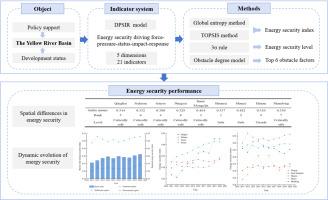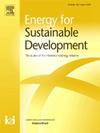Comprehensive evaluation of energy security in the Yellow River Basin based on the DPSIR-TOPSIS method
IF 4.9
2区 工程技术
Q2 ENERGY & FUELS
引用次数: 0
Abstract
As a critical demographic and economic corridor, the Yellow River Basin's energy security status exerts a direct influence on China's overall energy security. To investigate the spatiotemporal evolution of energy security within this region from 2011 to 2020, this study establishes a three-dimensional dynamic evaluation framework. An energy security index system comprising 21 indicators was developed based on the Driving force–Pressure–State–Impact–Response (DPSIR) model, integrating policy requirements and regional development characteristics. The global entropy method and the Technique for Order Preference by Similarity to an Ideal Solution (TOPSIS) method were employed to assess energy security performance, while an obstacle degree model identified critical influencing factors. Results indicate that energy security generally improved during the study period, with the average index values exhibiting a spatial pattern of midstream (0.510) > upstream (0.370) > downstream (0.320). Provincial trends diverged significantly: Gansu and Qinghai demonstrated pronounced upward trajectories, whereas Ningxia and Inner Mongolia experienced substantial fluctuations. Energy production and consumption emerged as dominant factors, with provinces actively promoting new energy initiatives gaining strategic advantages. Evidence-based policy implications are proposed to enhance energy security through optimized energy supply structures, regional coordination mechanisms, and clean consumption pathways.

基于DPSIR-TOPSIS方法的黄河流域能源安全综合评价
黄河流域作为重要的人口和经济走廊,其能源安全状况直接影响到中国的整体能源安全。为研究2011 - 2020年该区域能源安全的时空演变,建立了三维动态评价框架。基于动力-压力-状态-影响-响应(DPSIR)模型,结合政策要求和区域发展特点,构建了包含21个指标的能源安全指标体系。采用全局熵法和TOPSIS (Order Preference by Similarity to a Ideal Solution)方法对能源安全绩效进行评价,采用障碍度模型识别关键影响因素。结果表明:研究期间能源安全总体上有所改善,平均指数呈现中游(0.510)>的空间格局;上游(0.370)>;下游(0.320)。各省的趋势差异很大:甘肃和青海表现出明显的上升轨迹,而宁夏和内蒙古则经历了大幅波动。能源生产和消费成为主导因素,各省积极推进新能源建设取得战略优势。提出了优化能源供应结构、区域协调机制和清洁消费路径等加强能源安全的实证政策建议。
本文章由计算机程序翻译,如有差异,请以英文原文为准。
求助全文
约1分钟内获得全文
求助全文
来源期刊

Energy for Sustainable Development
ENERGY & FUELS-ENERGY & FUELS
CiteScore
8.10
自引率
9.10%
发文量
187
审稿时长
6-12 weeks
期刊介绍:
Published on behalf of the International Energy Initiative, Energy for Sustainable Development is the journal for decision makers, managers, consultants, policy makers, planners and researchers in both government and non-government organizations. It publishes original research and reviews about energy in developing countries, sustainable development, energy resources, technologies, policies and interactions.
 求助内容:
求助内容: 应助结果提醒方式:
应助结果提醒方式:


